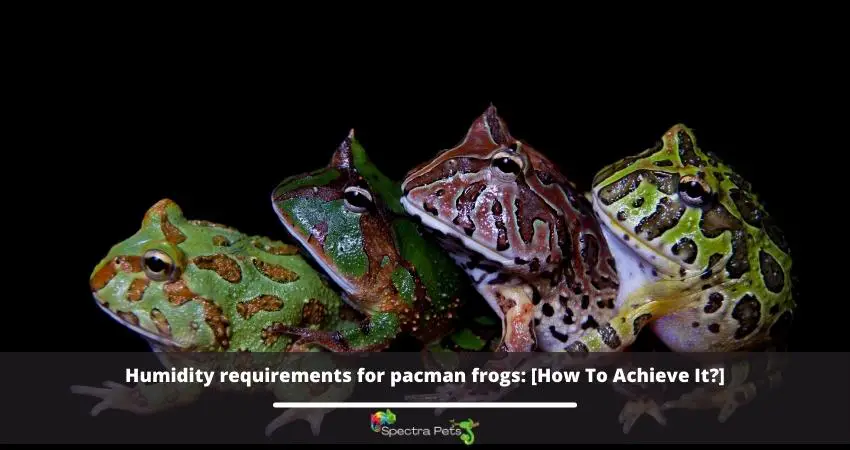When it comes to Pacman frogs, one of the most important things to remember is that they come from a very different environment than we do. In their natural habitat, Pacman frogs would likely never encounter a water dish, let alone have one inside their home.
While humidity is something that Pacman frogs have known their entire lives, too much of it can be problematic for them, after all, they’re not in nature; but rather trapped in a small area. The scope to adapt is significantly lower. This is why it’s your job as an owner to create an environment for them so that they can rest easy.
Here, I’m going to discuss the ideal humidity requirements for your Pacman frog to thrive. Keep reading to learn more.

Perfect Humidity Level for Pacman Frogs
Pacman frogs are highly sought-after pets among amphibian lovers due to their ease of maintenance. Getting the humidity right is all they need.
The best humidity for Pacman frogs is 50 – 80 percent. This range is comfortable for the frog and helps keep its skin moist. Anything higher or lower causes problems for your frog.
If the humidity drops below 50 percent, the frogs can become dehydrated. Similarly, too much humidity causes stress for the frogs. For example, a humidity of 100% could cause breathing problems due to lower free oxygen.
Because of this, it is crucial that their habitats maintain a constant level of moisture. If you are new to frog keeping, then you might be curious how exactly you’d accomplish this. Let’s show you how:
How to Monitor Humidity Levels?
Pacman frogs are terrestrial animals and spend most of their time on the ground. In the wild, Pacman frogs live in humid environments near bodies of water.
When kept as pets, Pacman frogs should be kept in terrariums that mimic their natural habitat. Now, inside a terrarium or a frog tank, the humidity will fluctuate, so to keep up with it, you need to keep a close eye.
You know, you could monitor humidity with naked eyes. If the humidity is too high, it’ll fog up the terrarium that houses your Pacman frog. But that’s not a highly reliable way to measure humidity levels for frogs. Besides you also can’t stare at your terrarium 24/7, I’m sure you have other things to do.
So, what do you do? We do what we do in the 21st century- use technology to make our lives easier! One of the most authentic ways to measure humidity is using the hygrometer. And nowadays hygrometers show you tons of data like real-time humidity, maximum humidity, minimum humidity, temperature, etc.
My recommendation is the hygrometer from Zoo Med. It’s super easy to install and use. And the readings are accurate as well.
So, get one of these and make your life easier.
How to Raise Humidity?

Unfortunately, even inside an enclosed space, the humidity won’t be the same at all times. So whenever the moisture in the air falls down, you need to supplement it yourself. But this is delicate work, there are some nuances involved.
I’ll briefly explain how to establish proper humidity levels for your Pacman frog’s terrarium
- A water dish is the most common way to increase humidity in a Pacman frog tank. But, just pouring in water won’t work immediately. You can place it near a heater to immediately vaporize the water. It’s better to use distilled or RO water.
- By misting, you keep your Pacman frog’s tank clean and prevent bacteria from growing. It’s a good idea to periodically mist the entire tank, including the frog, substrate, and accessories, with dechlorinated water. You’ll keep the humidity up and mold won’t grow. Additionally, misting lets you quickly spot dirt or debris in the tank or on the frog so you can get it cleaned up.
- A humidifier would also do the trick. That’s a low-effort way to keep the humidity up if you have some spare cash. Remember to refill the humidifier on a regular basis. But If we want to avoid an overly moist environment, that will be a small price to pay. The Zoo Med Repti Fogger is one that I’ll recommend.
How To Lower Humidity?
Since they’re originally from South America, many people think Pacman frogs are used to high humidity. Well, it’s true, they can sustain themselves better in humid areas. However, while high humidity is necessary for Pacman frogs, too much humidity can actually be hazardous.
Above 80% humidity, the risk of bacterial and fungal diseases increases, making your Pacman frog uncomfortable, and maybe even stressed. That’s why maintaining a delicate balance is so important. If you have too much humidity and want to lower it, here are some tips:
- You should either remove the water dish for a while or use a smaller dish in its place. However, keep an eye so that the humidity doesn’t lower too much.
- Increasing ventilation is another option. You can remove the lid or cover that engulfs the tank and let air come in. Having the tank partially open is also a great idea. Just make sure your frog doesn’t jump out. And if your terrarium doesn’t have a screened lid, replace it with one that has, it’ll make your life easier.
The Ideal Temperature For Pacman Frog
Whenever humidity comes into discussion, temperature follows. They go hand in hand. So when you’re trying to keep a balanced humidity, you also need to keep your room temperature in check.
During the day, the terrarium should be between 75 and 85 degrees Fahrenheit (24 to 29 Celsius). At night, the temperature should drop to between 65 and 75 F (18 to 24 C).
This may seem like a small range, but it’s essential for keeping your Pacman frog healthy and happy.
Invest in a good thermometer so you can always keep track of it.
Wrapping it up
There’s no doubt that Pacman frogs are different from the average pet. They are much more delicate than other common pets and require a lot of taking care of. Humidity is no joke for them, what might be a little change in humid conditions for us, could make a world of difference for them.
So, please try to keep them in their ideal conditions. You know what the humidity requirements are for your Pacman frog, so just replicate it. I’ve even shown you the means, good luck!
